- LEADING EDGE
- An alternative term for the dexter edge of a vertically hung banner or a gonfalon
– see ‘dexter edge’.

Please note, that this term has been introduced by the Editors
as a vexillological alternative to the heraldically derived ”dexter edge”.
- LEAFY CROWN
- A newly introduced term – and translation of the German Blattkrone – that may be
used to describe a crown which is apparently formed from a series of leaves (see also
‘crown of arms’,
‘hamburgian coronet’,
‘mural crown 1)’, and
‘provincial crown 2)’).

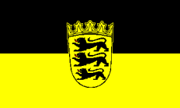
Lesser Arms and Civil Flag of Baden-Württemberg, Germany.
- LEAVED
- A term sometimes used in heraldic blazoning to indicate that a flower or
plant is shown complete with its stalk and leaves (see also
‘barbed’,
‘fructed’,
‘seeded’ and
‘slipped’).
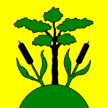
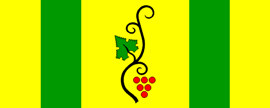
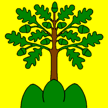
Flag of Müswangen, Switzerland;
Flag of Podlehnik, Slovenia;
Flag of Monthey, Switzerland
- LEECH
- The edge of a sail that lies opposite to its yard, and is used (in place of “at the peak” on
gaff-rigged vessels) to indicate the position of an ensign when flown from a halyard running from
the outer end of the mainsail boom to the mast of a Bermuda rigged sailing yacht – instead of from
an ensign staff at the stern (see also
‘ensign 1)’,
‘gaff’,
‘halyard’,
‘peak’ and
‘yard’).
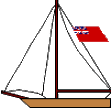

Ensign Flown At The Leech: Ensign At The Peak
Please note that an ensign should always be flown from an ensign staff at the stern whilst at anchor or berthed alongside.
- LEFT DIAGONAL (or LEFT DIAGONAL BAR)
- See ‘ascending diagonal 1)’ and
‘bend sinister’.
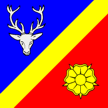
Flag of Servion, Switzerland
- LEFT-HOISTED
- A term that may be used (in place of its heraldic equivalent) when the obverse of a
flag is depicted (or is manufactured) with its hoist to the observer’s left in accordance
with Western tradition – but see
‘dexter hoist’ and the note below (also
‘hoist 1)’ and
‘obverse’).
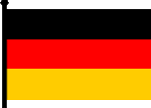
National Flag of Germany
Please note that the Editors recommend use of the heraldic term as being more
accurate and will avoid any potential confusion.
- LEGGED
- In heraldry see ‘membered’.
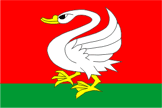
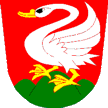
Flag and Arms Černošín, Czechia
- LEISURE ENSIGN
- See ‘yacht ensign’ under ‘ensign’.
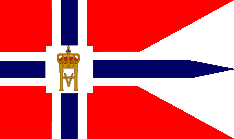
Ensign of the Royal Norwegian Yacht Club
- LENGTH
- 1) That dimension of a flag which is measured horizontally from the outside
edge of the hoist (generally excluding the heading), to the opposite extreme edge
of the fly (see also ‘Appendix I’,
‘width’, ‘heading’,
‘hoist’ and ‘fly’).
- 2) The longer dimension of a stripe or band within a flag – howsoever orientated
(see also ‘stripe’).
- 3) The dimension of an emblem, charge, arms, shield or badge measured horizontally,
when it appears on a flag – but see the note below, ‘height’
and ‘width across’ (see also ‘badge’,
‘charge’, ‘emblem’
'establishment of arms'
and ‘shield’).

Please note that definition 3) is given with regard to the consistent
use of proportions when describing a flag and its charges, however, it is suggested that when
giving the actual dimensions of any such charge the phrase ‘width across’ should be used for its
horizontal measurement and the word ‘height’ for its vertical size (see also
‘dimensions’ and
‘proportions’).
- LESSER ARMS
- See under ‘arms’.


Lesser Arms of
Bavaria, Germany and of Sweden
- LETTER OF MARQUE (and/or REPRISAL)
- See ‘privateer(s)’ and
its following note.
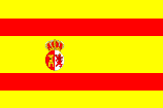
Privateer Ensign, Spain 1820

















